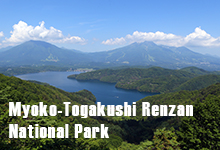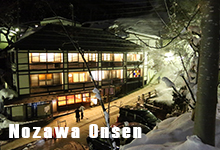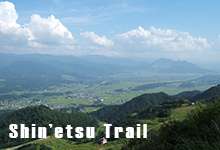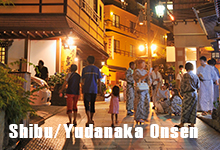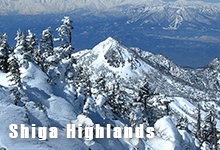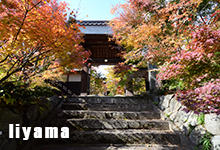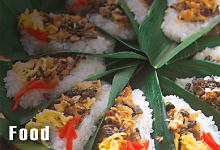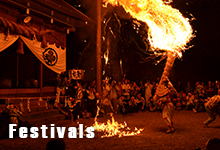Home > ABOUT > The Seasons of Shinetsu Shizenkyo
The Seasons of Shinetsu Shizenkyo
A landscape colored by flowers
Shinetsu Shizenkyo is known for flowers of every hue, which bloom throughout the season. Their delicate scent drifts through the fresh spring air.
Shinetsu's unique culture is due in part to the area's cold weather and heavy snowfall. When winter gives way to long awaited spring and the snow begins to melt, the flowers seem to burst into bloom all at once. The cherry trees of each district bloom one after another, as though racing, and the delicate pink peach blossoms are bright against the still snow-topped mountains. Rose-pink buds open to reveal bright white apple blossoms, found only in this region. A light fragrance envelops the fields of flowers. Along the banks of the Chikuma River, bright yellow canola flowers announce the arrival of spring, while skunk cabbage plants cloak themselves in pure white. These flowers perch atop the first greenery of Shinetsu Shizenkyo spring. Bursting with new life, these fields of bright flowers promise new opportunities, and maybe a little magic.

An experience of traditional Japan
Shinetsu Shizenkyo preserves nearly forgotten tradition and gorgeous untouched landscapes, including traditional Japanese summer events.
The classic Japanese song "Furusato (hometown)," was written as an ode to the idyllic scenery of the Shinetsu area. For Japanese people, these landscapes in summer bring to mind the ease of childhood. The soft tinkling of wind chimes, gentle breezes from a folding paper fan, and perhaps the taste of chilled tomatoes or watermelon. Even today, visitors can enjoy similar pursuits, chasing insects in the forest, fishing in the small streams, or going for a swim in the cool water. The gently flowing Chikuma River - the largest river in Japan - offers opportunities for rafting and canoeing, while vibrant green mountain highlands are the departure point for a variety of hiking courses. The August Bon festival is celebrated with fireworks and a traditional ceremony featuring candles floating on the river. These customs, carried on for hundreds of years, preserve the culture and elegance of traditional Japan.

Harvesting the fruits of the earth
The rich earth is tilled with techniques passed down through generations, producing huge harvests of fruits, vegetables, and rice.
The Shinetsu harvest season begins when rice stalks glow golden in the sun and fields of apples flush red. For generations, local people have understood the language of nature, developing fertile paddies and fields that reward farmers with bumper crops in fall. Over time, the foothills of this mountainous region were cleared and leveled to create terraced rice paddies, combining hard work with time-tested agricultural knowledge. Walk into the vast fields of fruit trees to catch a glimpse of farm families working together to bring in the harvest. These scenes have a timeless quality, with fruit picking carried out much as it has been for decades. Surrounded by nature, the produce from this area is fresh, free of pesticides, and delicious enough to eat raw, one of the hallmarks of Shinetsu Shizenkyo.

The charms of winter snowfall
In winter, beautiful scenery and severe weather go hand in hand.
Largely cut off from other areas in winter, harsh conditions in Shinetsu encouraged the development of a unique local culture.
Known for its heavy snowfall, Shinetsu Shizenkyo's gorgeous winter landscapes offer a unique view of Japan's snow country. For generations, local people have passed down traditional folk knowledge, supporting each other through the snowy season.
Some of Shinetsu's downtown shopping districts preserve the region's trademark architecture - traditional arcade-style roofing known as "gangi." This roofing, along with "yukigakoi" snow sheds, protected shops from snow, allowing
commerce to continue during the winter months.
Even today, winter snowfall in Shinetsu can be hard to believe, with towering dunes of snow reaching 10 meters high in some areas. The snow seems to form natural works of art,
with sculpture-like formations and thick icicles decorating the landscape.
Many Shinetsu districts celebrate winter with yearly snow festivals. With agricultural work on hold, local people also produce a variety of traditional
crafts, including straw-woven baskets and snow-bleached Uchiyama paper. When the winter snows finally begin to fade, meltwater runs into the Chikuma River and sustains the region's ancient beech forests.



